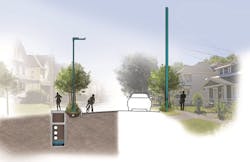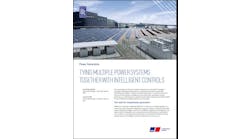Susan Dieterlen of DeftSpace Lab offers a model to improve the visibility of community microgrids and make urban revitalization initiatives more substantial and effective.
Susan Dieterlen of DeftSpace Lab
It’s no secret that American cities have many neighborhoods in need of economic revitalization. These challenged neighborhoods may be most common in the Rustbelt, but nearly every city across the nation has at least a few. Accordingly, efforts to encourage investment in these neighborhoods are also common across the country. Less common is the inclusion of community microgrids in these revitalization efforts.
A 2015-16 study at Syracuse University investigated the potential of community microgrids to support urban revitalization efforts, and how such microgrids might be replicated across all similar upstate neighborhoods. Based on the NY Prize Phase I award for Syracuse’s Near Westside, this replication extended the goal of multi-purpose microgrids, since far more benefit can be realized by repeating such microgrids in many neighborhoods instead of just one.
Resilient power systems for challenged urban neighborhoods, those plagued with urban blight in central cities, can be usefully combined with economic revitalization incentives and investment in public infrastructure.
By deriving more benefit from the same system, this strategy maximizes each dollar of project budget. Disadvantaged urban areas progress toward common urban planning and design goals, while expanding new markets for those who design and install microgrids. Combining community microgrids with other infrastructural improvements also cultivates the possibility of public infrastructure funding, a topic much in the national conversation.
Revitalization
“Revitalization” here refers to increasing private and public investment in a neighborhood, which may in turn spur other kinds of community strengthening. This investment can reverse the fortunes of neighborhoods plagued by the loss of manufacturing jobs, residents, and other businesses over the past several decades. Such neighborhoods often experienced their peak population in 1950, with multiple decades of subsequent decline.
Diminished tax revenue as well as declines in private investment, including property values and maintenance, create the all-too-familiar landscape of dilapidated buildings, vacant land (often 10 percent of parcels or greater), and crumbling infrastructure. These neighborhoods often need multiple infrastructure improvements, not just electrical systems, but also drinking water, sanitary and storm sewers (especially where they are combined), street paving, and so on. Infrastructure needs also include the addition of new amenities attractive to new residents and businesses, such as broadband and facilities for bicyclists and pedestrians.
These many improvements are usually restricted to the public right-of-way along city streets, dictating careful use of space and smart construction strategies like Dig Once. This same need for coordination may also open microgrid development to public funding, especially that targeted to infrastructure or revitalization.
An alternative to tax incentives
Revitalization initiatives typically involve tax incentives, which can be challenging in the current political climate. The incorporation of neighborhood microgrids opens the door to alternative non-tax incentives, through efficiency improvements, lower energy costs, and greater reliability. District thermal systems may provide even more attractive incentives, given the older average age of building stock, its frequent lack of weatherization updates, and the high density of urban properties. The March 6 column in this same space on “Microgrids for Social Justice,” makes a strong case for the benefits microgrids offer disadvantaged neighborhoods; revitalization efforts target many of these same areas. The key question is who receives the financial benefits, and if financial models can be put in place that allow enough of this benefit to go to individual ratepayers. Incentivizing revitalization with these benefits could be one way to monetize the resilience benefits of microgrids, adding to recent innovations in financing.
Perception is everything
Public perception and neighborhood reputation are key to revitalization. At heart, all initiatives seek to improve the perception of the area, shaping its reputation as a promising location for buying or improving property. Tangible improvements, like microgrids, assist in this, demonstrating faith in the future of the area by those making the investments. Revitalization efforts often include urban design improvements, such as decorative sidewalk paving and ornamental street lights. These are frequently criticized as offering only aesthetic benefit, without improving services or amenities. The addition of a community microgrid makes these improvements far more substantive, offering both benefits for current residents and the attraction of more reliable, higher-quality power for new businesses.
However, the ability of microgrids to influence perception is limited by their virtual invisibility to the general public. Infrastructure in general is not noticeable to the layperson, until it fails. The innovative nature of microgrid components is not at all apparent to the non-expert. For a microgrid to boost a neighborhood’s reputation, it needs to be visible to the public. This visibility could be achieved through the design of the microgrid components themselves, as well as through the integration of the microgrid with other infrastructure improvements in that crowded right-of-way. (See graphic below.)
Figure 1: A design for an integrated microgrid, infrastructure, and revitalization improvements in an urban neighborhood. Courtesy of DeftSpace Lab
A branding effort for the neighborhood, another revitalization mainstay, would be helpful here, and unusually effective when combined with the greater substance of the improvements provided by the microgrid. The combination of microgrid, infrastructure, and revitalization creates interesting possibilities, such as high-efficiency street lights that are locally powered and act as transmitters for civic broadband, or replaceable heated sidewalk panels that cover combined utility tunnels and underground stormwater detention.
This visibility strategy also addresses the difficulty of communicating the substantial sustainability value of more efficient generation and storage. Unlike wind or photovoltaic generation, the greenhouse gas reduction of more efficient systems is invisible to the public. The design strategy presented here works with or without renewables.
In summary, the incorporation of community microgrids in urban revitalization offers to make revitalization initatives more substantial and effective while improving the visibility of microgrids and other infrastructure. Using two problems to solve each other is the best kind of multiple benefit, and a very promising recipe for many challenged urban areas.
Susan Dieterlen is the founder of DeftSpace Lab.







